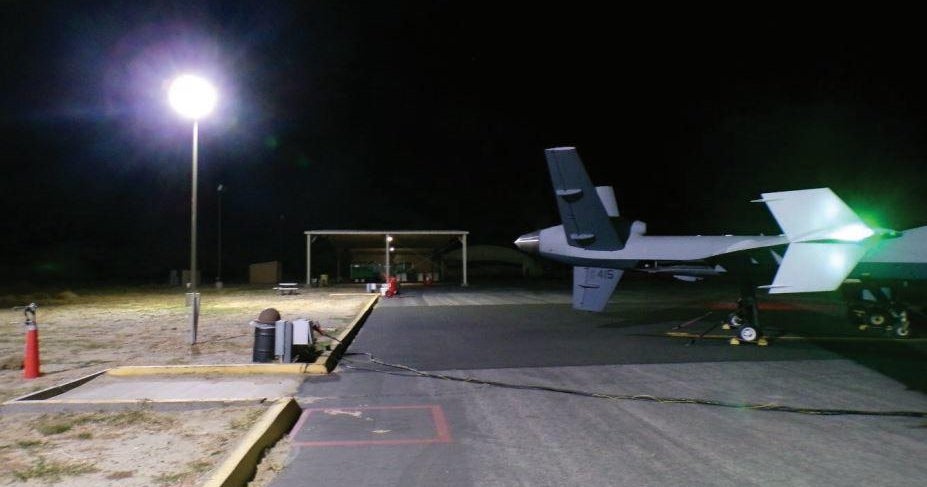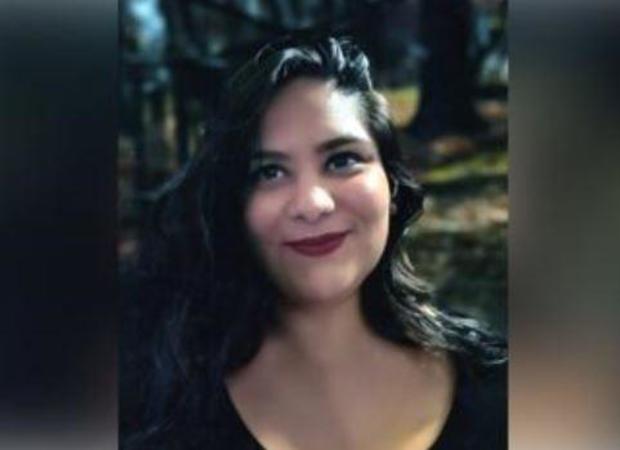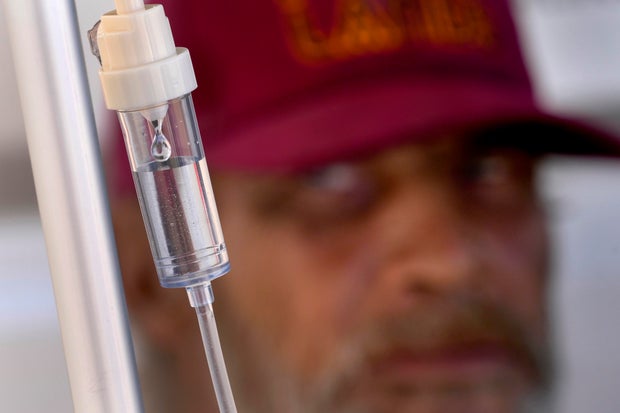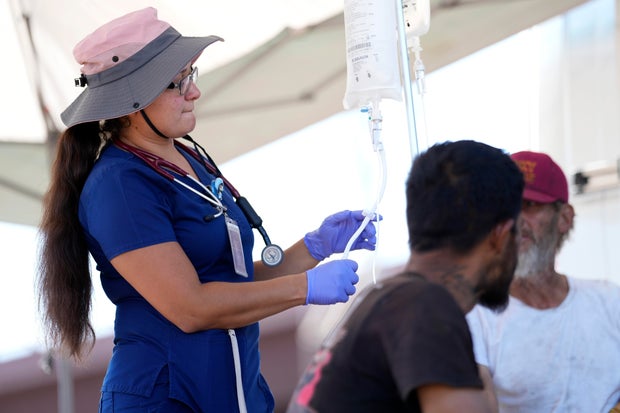CBS News
Contractor killed by aircraft propeller lost “situational awareness” when she was fatally struck, Air Force says

A civilian contract employee who was killed when she walked into the moving propeller of an unmanned aircraft at a Southern California airfield in September lost “situational awareness” before the fatal incident, Air Force officials said Friday. A detailed investigation report revealed the frantic moments just before and after 32-year-old Stephanie Cosme was fatally struck as she carried out testing at Gray Butte Airfield.
Cosme, of Palmdale, California, was working as a test engineer on the evening of Sept. 7, 2023, when she accidentally walked into the rotating propeller of a parked MQ-9A Reaper drone while performing a ground test on the aircraft, according to a final accident investigation report. The 40-page report concluded there were two underlying reasons for the accident — first, that Cosme was incorrectly trained on how to take telemetry readings when approaching the aircraft and, second, “she lost situational awareness while walking around” the drone as she took readings with a hand-held device.
Brig. Gen. Lance R. French said two other factors also “substantially contributed to the mishap,” including a lack of communication between the contractor test team and ground support workers and, because of previous delays, “the tests conducted on Sept. 7 were rushed.”
Cosme, who was employed by Sumaria Systems, LLC, was providing test support services when she was fatally struck.
According to the report, after taking measurements with a power meter, Cosme walked down the right side of the fuselage toward the rear of the aircraft, “looking down at the testing device the whole time, and appeared to be pressing buttons, possibly to keep the backlight on.” As she came closer to the propeller, colleagues began “shouting and waving” in an attempt to get her attention, the report said.
“Without looking up to determine her position relative to the aircraft, (Cosme) proceeded to walk directly into the propeller of the (aircraft) sustaining fatal injuries,” the report said.
Just before 7:58 p.m., the engine RPM dropped from 100% to 99% and engine torque jumped from 16% to 31% — apparently the moment of impact. Seconds later, the report says, the crew chief yelled over the radio to the aircrew, “Kill, kill, kill, kill!” Moments later, a crew member can be seen on the aircraft’s front camera running from right to left, presumably running to the drone’s kill switch.
United States Air Force
Cosme, who was struck in the head and the left arm, was unresponsive when team members arrived. Resuscitative efforts were unsuccessful and she was pronounced dead at 9:06p.m.
In its report, the Air Force said officials later attempted to replicate the fatal sequence of events in the same spot with the drone’s engine running at the same power setting with similar twilight conditions and airfield lighting that were present on the night Cosme was killed. In that simulation, the propeller was not visible when looking to the rear of the aircraft, from where Cosme approached.
An obituary posted on Legacy.com noted that Cosme was “known for her passion for crafting, baking, aviation, and all things strange and unusual.” She was survived by her parents, two siblings, fiance and stepdaugher.
Legacy.com
“Though her time on this Earth was far too brief, Stephanie left a lasting legacy of love and kindness that will continue to shine brightly,” the obituary reads.
The MQ-9A Reaper is a U.S. Marine Corps drone that performs intelligence, surveillance and reconnaissance missions over land or sea, according to the Air Force. The $56.5 million aircraft is 36 feet long and has a 66-foot wingspan. A Reaper drone can reach an altitude of up to 50,000 feet and carry up to eight laser-guided Hellfire missiles, according to the Air Force.
Reaper drones have been used to carry out U.S. military attacks, including the 2020 strike that killed top Iranian military commander Qassem Soleimani in Iraq, and in 2021 against the Taliban as the militants were regaining control of Afghanistan amid the pullout of U.S. forces.
Alex Sundby contributed to this report.
CBS News
Meet the designer turning classic Venetian glass into modern art

Watch CBS News
Be the first to know
Get browser notifications for breaking news, live events, and exclusive reporting.
CBS News
Minnesota Vikings rookie Khyree Jackson dies in car accident

MINNEAPOLIS — Minnesota Vikings rookie Khyree Jackson died overnight in a car accident.
The Upper Marlboro, Maryland native played for Alabama and Oregon. He was drafted by the Vikings in April in round 4 as the 108th overall pick.
He was 24 years old.
“Our thoughts are with Khyree’s family, friends, teammates and coaches, as well as all the victims of this tragic accident,” the Vikings wrote on X.
Vikings head coach Kevin O’Connell said he was “crushed” by the news of Jackson’s death.
“In our short time together, it was evident Khyree was going to develop into a tremendous professional football player, but what was more impressive was his desire to become the best person he could be for his family and those around him,” O’Connell added.
The crash happened in Upper Marlboro shortly after 3 a.m. and involved three cars, according to Maryland state police. Investigators believe the driver of a silver Infiniti car tried to change lanes at a high rate of speed and struck the car that Jackson was in, as well as a Chevrolet Impala.
The two other occupants of Jackson’s car also died in the crash. The occupants of the other cars were not hurt.
Officials believe that alcohol could have been a contributing factor in the crash.
In a statement, the Minnesota Vikings say they have offered support to Jackson’s family, and are offering counseling and emotional support to the players who seek it.
This is a developing story. Check back with WCCO.com for more.
Note: The above video first aired on June 24, 2024.
CBS News
Street medics treat heat illnesses among homeless people as temperatures rise

Alfred Handley leaned back in his wheelchair alongside a major Phoenix freeway as a street medicine team helped him get rehydrated with an intravenous saline solution dripping from a bag hanging on a pole.
Cars whooshed by under the blazing 96-degree morning sun as the 59-year-old homeless man with a nearly toothless smile got the help he needed through a new program run by the nonprofit Circle the City.
“It’s a lot better than going to the hospital,” Handley said of the team that provides health care to homeless people. He’s been treated poorly at traditional clinics and hospitals, he said, more than six years after being struck by a car while he sat on a wall, leaving him in a wheelchair.
Circle the City, a non-profit that works in multiple cities and hospitals and treats about 9,000 people annually, introduced its IV rehydration program as a way to protect homeless people in Phoenix from life-threatening heat illness as temperatures regularly hit the triple-digits in America’s hottest metro.
Matt York / AP
Homeless people accounted for nearly half of the record 645 heat-related deaths last year in Maricopa County, which encompasses metro Phoenix. As summers grow warmer, health providers from San Diego to New York are being challenged to better protect homeless patients.
Dr. Liz Frye, vice chair of the Street Medicine Institute which provides training to hundreds of healthcare teams worldwide, said she didn’t know of groups other than Circle the City administering IVs on the street. The organization also distributes tens of thousands of water bottles each summer and tries to educate people about hot weather dangers.
“But if that’s what needs to happen to keep somebody from dying, I’m all about it,” Frye said.
Bringing care to people in need
The amount of people requiring treatment for heat illnesses is rising. The Boston Health Care for the Homeless Program, featured in last year’s book, “Rough Sleepers,” now sees patients with mild heat exhaustion in the summer after decades of treating people with frostbite and hypothermia during the winter, said Dr. Dave Munson, the street team’s medical director.
“It’s certainly something to worry about,” said Munson, noting that temperatures in Boston hit 100 degrees with 70% humidity during June’s heat wave. Homeless people, he said, are vulnerable to very hot and very cold weather not only because they live outside, but they often can’t regulate body temperature due to medication for mental illness or high blood pressure, or because of street substance use.
The Phoenix team searches for patients in homeless encampments in dry riverbeds, sweltering alleys and along the canals that bring water to the Phoenix area. About 15% are dehydrated enough for a saline drip.
Matt York / AP
“We go out every day and find them,” said nurse practitioner Perla Puebla. “We do their wound care, medication refills for diabetes, antibiotics, high blood pressure.”
Puebla’s street team ran across Handley and 36-year-old Phoenix native Phillip Enriquez near an overpass in an area frequented by homeless people because it’s near a facility offering free meals. Across the road was an encampment of tents and lean-tos along a chain-link fence.
Enriquez sat on a patch of dirt as Puebla started a drip for him. She also gave him a prescription for antibiotics and a referral to a dentist for his dental infection.
Living outside in Arizona’s broiling sun is hard, especially for people who may be mentally ill or use sedating drugs like fentanyl that make them less aware of their surroundings. Stimulants like methamphetamine contribute to dehydration, which can be fatal. Dr. Matt Essary, who works with Circle in the City’s mobile clinics, said the organization also often treats surface burns that can happen when a medical emergency or intoxication causes someone to fall on a sizzling sidewalk.
Matt York / AP
Temperatures this year have reached 115 degrees in metro Phoenix, where six heat-related deaths have been confirmed through June 22. Another 111 are under investigation, and the city is seeing an “increasing” number of patients with heat illnesses every year, according to Dr. Aneesh Narang, the assistant medical director of emergency medicine at Banner Medical Center-Phoenix, which treats many homeless people with heat stroke.
Narang’s staff works frequently with Circle the City, whose core mission is providing respite care, with 100 beds for homeless people not well enough to return to the streets after a hospital stay.
Extreme heat worldwide requires a dramatic response, said physician assistant Lindsay Fox, who cares for homeless people in Albuquerque, New Mexico, through an initiative run by the University of New Mexico’s School of Medicine.
Three times weekly, Fox treats infections, cleans wounds and manages chronic conditions in consultation with hospital colleagues. She said the prospect of more heat illness worries her.
Highs in Albuquerque can hit the 90s and don’t fall enough for people living outside to cool off overnight, she said.
“If you’re in an urban area that’s primarily concrete, you’re retaining heat,” she said. “We’re seeing heat exposure that very quickly could go to heat stroke.”
Serious heat stroke is far more common in metro Phoenix, where Circle the City is now among scores of health programs for the homeless in cities like New York, San Diego and Spokane, Washington.
Circle the City works with medical staff in seven Phoenix hospitals to help homeless patients get after-care when they no longer need hospitalization. It also staffs two outpatient clinics for follow-up.
Rachel Belgrade waited outside Circle the City’s retrofitted truck with her black-and-white puppy, Bo, for Essary to write a prescription for the blood pressure medicine she lost when a man stole her bicycle. She accepted two bottles of water to cool off as the morning heat rose.
“They make all of this easier,” said Belgrade, a Native American from the Gila River tribe. “They don’t give you a hard time.”













